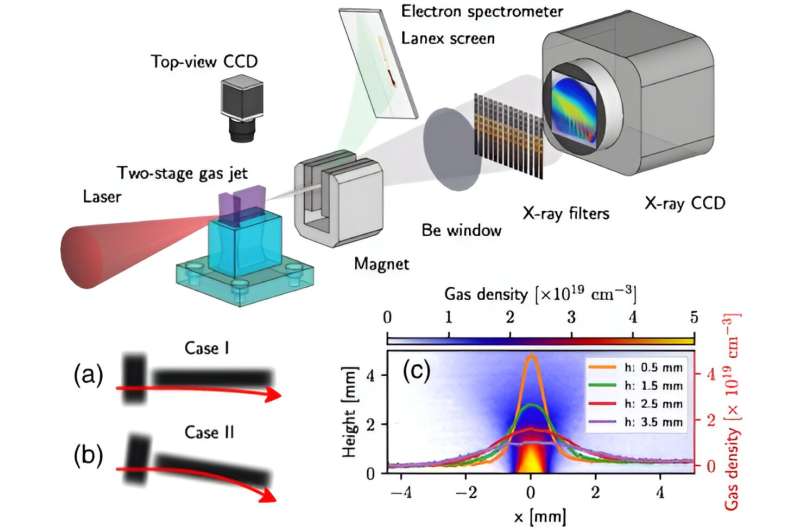This article has been reviewed according to Science X's editorial process and policies. Editors have highlighted the following attributes while ensuring the content's credibility:
fact-checked
peer-reviewed publication
trusted source
proofread
Researchers capture detailed picture of electron acceleration in one shot

Adjusting experimental methods achieved the first "single-shot" diagnosis of electron acceleration through a laser wakefield accelerator along a curved trajectory, according to a recent study led by University of Michigan researchers. The findings are published in the journal Physical Review Letters.
This optical-based technique could help engineers develop more powerful electron accelerators for fundamental studies of quantum and particle physics—or more compact accelerators for use in medicine and industry.
Compared to traditional accelerators which can be kilometers long, laser wakefield accelerators can apply 1000 times more energy per meter, allowing a vastly more compact design able to fit into a large room.
The device fires a laser through a vapor, creating an ionized plasma, then separates electrons from ions which creates a "wakefield," similar to the wake a boat leaves behind as it moves through water. It then injects an electron beam into the accelerator which "surfs" on the wake, gaining energy rapidly.
"The beam of particles that comes out of a laser plasma accelerator is so short in duration, it would take less time for light to cross the width of a hair. The whole acceleration process is so fast, on a trillionth-of-a-second time scale, that it is extremely difficult to measure," said Alexander Thomas, a professor of nuclear engineering and radiological sciences, electrical engineering and computer science and physics at U-M and senior author of the study.
Up to this point, electron acceleration processes have been measured through multiple experimental runs, called a multi-shot mode, but those methods rely on the stability and reproducibility of the accelerator—leaving room for variations between experiments.
"It is essential to precisely diagnose the electron acceleration process to maximize the electron energy gain. This could be a crucial step pushing forward the development of the future teraelectronvolt (TeV) level lepton colliders used to understand the fundamental laws of nature," said Thomas.
The research team accomplished single-shot electron acceleration diagnosis during an experiment conducted on a laser wakefield accelerator at the Advanced Laser Light Source of the Institut National de la Recherche Scientifique in Quebec, Canada.
The technique relies on a phenomenon that occurs during laser wakefield acceleration known as "betatron X-ray radiation" where electrons emit high energy photons in the X-ray region of the electromagnetic spectrum while oscillating transversely.
"In our work, we steer the intense laser light with a plasma density ramp so that the laser light follows a curved trajectory, as does the electron beam accelerated in the wake of the laser light," said Yong Ma, an assistant research scientist of nuclear engineering and radiological sciences at U-M and corresponding author of the study.
The photons emitted by the electron always follow the tangent direction of its instantaneous trajectory. Thus, photons emitted at different times appear at different angles and thus different spatial locations on a screen.
The properties of the photons, namely photon energies and angular distribution, are completely determined by the properties of the electron beam. Therefore, by measuring the properties of the spatially resolved photon, the researchers were able to piece together the electron acceleration process from a single experiment.
"We had this basic idea using the so-called 'betatron streaking' technique seven years ago and we demonstrated its feasibility using numerical simulations. It was quite an exciting and fun experience to perform an experiment based on numerical simulations and get expected experimental results," said Ma.
"It is a great result that could open new avenues for a detailed understanding of laser-plasma accelerators," said Dr. Daniel Seipt of the Helmholtz-Institute Jena, a senior author of the study who provided the theoretical support.
Results could find applications in advanced control of laser beam and particle propagation—for example, developing curved plasma channels for coupling multistage laser wakefield accelerators.
A multistage wakefield accelerator would overcome the energy limitations of a single-stage accelerator, achieving higher energies for particles. These high energies could be used for quantum mechanics experiments, similar to those done on the Large Hadron Collider at the CERN, but on a smaller, less expensive scale.
Beyond quantum exploration, multistage laser wakefield accelerators could eventually be applied for practical use for targeted tumor destruction in cancer treatments or cutting materials with limited heat damage in industrial settings.
More information: Y. Ma et al, Single-Shot Diagnosis of Electron Energy Evolution via Streaked Betatron X Rays in a Curved Laser Wakefield Accelerator, Physical Review Letters (2024). DOI: 10.1103/PhysRevLett.132.225001
Journal information: Physical Review Letters
Provided by University of Michigan College of Engineering



















